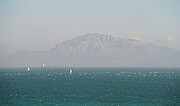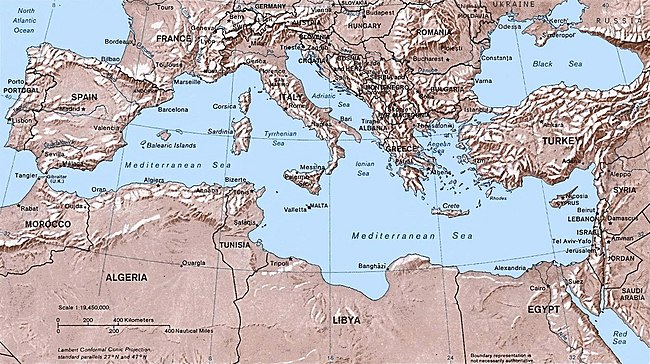Mediterranean Sea
From Wikipedia, the free encyclopedia.
The Mediterranean Sea is a part of the Atlantic Ocean almost completely enclosed by land, on the north by Europe, on the south by Africa, and on the east by Asia. It covers an approximate area of 2.5 million km² (965 000 mi²). It is also called the Eurafrican Mediterranean Sea or the European Mediterranean Sea in oceanography to distinguish it from other mediterranean seas in the world.
It was a superhighway of transport in ancient times, allowing for trade and cultural exchange between emergent peoples of the region — Egyptians, Greeks, Romans, and the Middle-East (Arab/Persian/Semitic) cultures. The history of the Mediterranean is important in understanding the origin and development of Western Civilization.
Contents |
Name
The term Mediterranean derives from the Latin mediterraneus, 'inland' (medius, 'middle' + terra, 'land, earth'), in Greek "mesogeios".
The Mediterranean Sea has been known by a number of alternative names throughout human history. It was, for example, commonly called Mare Nostrum (Latin, Our Sea) by the Romans. In the Bible, it is referred to as the Great Sea or the Western Sea. In modern Hebrew, it is called "ha-Yam ha-Tichon" (הים התיכון), "the middle sea", a literal adaptation of the German equivalent Mittelmeer. In Turkish, it is Akdeniz, "the white sea".
Currently, "The Med" is a common English language contraction for the Mediterranean Sea and its surrounding regions when employed in informal speech.
Geography
The Mediterranean Sea is connected to the Atlantic Ocean by the Strait of Gibraltar on the west and to the Sea of Marmara and Black Sea, by the Dardanelles and the Bosporus respectively, on the east. The Sea of Marmara is often considered a part of the Mediterranean Sea, whereas the Black Sea is generally not. The man-made Suez Canal in the south-east connects the Mediterranean Sea with the Red Sea.
Tides are very limited in the Mediterranean as a result of the narrow connection with the ocean.
The Mediterranean climate is generally one of wet winters and hot, dry summers. Special crops of the region are olives, grapes, oranges, tangerines, and cork. The region has a long history of civilization.
Large islands in the Mediterranean include:
- Cyprus, Crete, Euboea and Rhodes in the eastern Mediterranean
- Sardinia, Corsica, Sicily, and Malta in the central Mediterranean
- Ibiza, Majorca and Minorca (the Balearic Islands) in the western Mediterranean
Bordering countries
Modern states bordering the Mediterranean Sea are:
- Europe (from west to east): Spain, France, Monaco, Italy, the island state of Malta, Slovenia, Croatia, Bosnia and Herzegovina, Serbia and Montenegro, Albania, Greece, Turkey, and the island state of Cyprus.
- Asia (from north to south): Turkey, Syria, Lebanon, Israel, the Gaza Strip and Egypt.
- Africa (from east to west): Egypt, Libya, Tunisia, Algeria and Morocco
Subdivisions

The Mediterranean Sea is sub-divided into a number of smaller seas, each with their own designation (from west to east):
- the Alboran Sea, between Spain and Morocco,
- the Ligurian Sea between Corsica and Liguria (Italy),
- the Tyrrhenian Sea enclosed by Sardinia, Italian peninsula and Sicily,
- the Adriatic Sea between the Italian peninsula and the Dalmatian coast,
- the Ionian Sea between Italy and Greece,
- the Aegean Sea between Greece and Turkey, with
- the Thracian Sea in its north,
- the Mirtoon Sea between the Cyclades and the Peloponnesos,
- the Sea of Crete north of Crete, and
- the Sea of Marmara between the Aegean and Black Seas.
In addition to the seas, a number of gulfs and straits are also recognised:
- the Gulf of Lyon, south of France
- the Strait of Messina, between Sicily and the toe of Italy
- the Gulf of Taranto, southern Italy,
- the Gulf of Haifa, between Haifa and Akko, Israel
- the Gulf of Sidra, between Tunisia and Cyrenaica (eastern Libya)
- the Strait of Sicily, between Sicily and Tunisia
- the Corsica Channel, between Corsica and Italy
- the Strait of Bonifacio, between Sardinia and Corsica
- the Gulf of Iskenderun, between Iskenderun and Adana(Turkey).
- the Gulf of Antalya, between west and east shores of Antalya(Turkey).
Geology
The geology of the Mediterranean is complex, involving the break-up and then collision of the African and Eurasian plates, and the Messinian Salinity Crisis in the late Miocene when the Mediterranean dried up.
The Mediterranean Sea has an average depth of 1,500 m and the deepest recorded point is 5267 meters = about 3.27 miles in the Calypso Deep in the Ionian Sea. The coastline extends for 46,000 km. A shallow submarine ridge (the Strait of Sicily) between the island of Sicily and the coast of Tunisia divides the sea in two main subregions (which in turn are divided into subdivisions), the Western Mediterranean and the Eastern Mediterranean. The Western Mediterranean covers an area of about 0.85 million km² and the Eastern Mediterranean about 1.65 million km².
In the last few centuries, humankind has done much to alter Mediterranean geology. Structures have been built all along the coastlines, exacerbating and rerouting erosional patterns. Many pollution-producing boats travel the sea that unbalance the natural chemical ratios of the region. Beaches have been mismanaged, and the overuse of the sea's natural and marine resources continues to be a problem. This misuse speeds along and/or confounds natural processes. The actual geography has also been altered by the building of dams and canals.
The Mediterranean was once thought to be the remnant of the Tethys Ocean. It is now known to be a structurally younger ocean basin known as Neotethys. Neotethys formed during the Late Triassic and Early Jurassic rifting of the African and Eurasian plates.
There have been theories that the Mediterranean reflooded after Man reached the area, causing the Biblical Flood legend. However, the Strait of Gibraltar is too deep to have dried out in the Ice Age, and the Flood legend may recall the Black Sea re-flooding.
Ecology
As a result of the drying of the sea during the Messinian Salinity Crisis, the marine biota of the Mediterranean are derived primarily from the Atlantic Ocean. The North Atlantic is considerably colder and more nutrient-rich than the Mediterranean, and the marine life of the Mediterranean has had to adapt to its differing conditions in the five million years since the basin was reflooded.
The opening of the Suez Canal in 1869 created the first salt-water passage between the Mediterranean and Red seas. The Red Sea is higher than the Eastern Mediterranean, so the canal serves as a salt-water river that pours Red Sea water into the Mediterranean. The Bitter Lakes, which are hypersaline natural lakes that form part of the canal, blocked the migration of Red Sea species into the Mediterranean for many decades, but as the salinity of the lakes gradually equalized with that of the Red Sea, the barrier to migration was removed, and plants and animals from the Red Sea have begun to colonize the eastern Mediterranean. The Red Sea is generally saltier and more nutrient-poor than the Atlantic, so the Red Sea species have advantages over Atlantic species in the salty and nutrient-poor Eastern Mediterranean. The construction of the Aswan High Dam across the Nile River in the 1960s reduced the inflow of freshwater and nutrient-rich silt from the Nile into the eastern Mediterranean, which has made conditions there even more like the Red Sea. This species exchange is known as the Lessepsian Migration, after Ferdinand de Lesseps, the engineer who oversaw the canal's construction.
See also
- Seaports of Valencia (Spain)
- Mediterranean Basin
- Mediterranean forests, woodlands, and shrub
- Familial Mediterranean fever
- History of the Mediterranean
- Holy League (Mediterranean)
- Seto Inland Sea, which is sometimes named the Japanese Mediterranean Sea
- History of the Suez Canal
External links
| Countries in the Mediterranean |
|---|
| Albania | Algeria | Bosnia and Herzegovina | Croatia | Cyprus | Egypt | France | Greece | Israel | Italy | Lebanon | Libya | Malta | Monaco | Morocco | Serbia and Montenegro | Slovenia | Spain | Syria | Tunisia | Turkey |
| Regions of the World | |
| Africa: | Central Africa | East Africa | Great Lakes | Guinea | Horn of Africa | North Africa | Maghreb / Northwest Africa | Sahel | Southern Africa | Sub-Saharan Africa | Sudan | West Africa |
| Americas: | Andean states | Caribbean | Central America | Great Lakes | Great Plains | Guianas | Latin America | North America | Patagonia | South America | Southern Cone |
| Asia: | Central Asia | East Asia | East Indies | Far East | Indian subcontinent | North Asia | Southeast Asia | Southwest Asia (Middle East / Near East, Levant, Anatolia, Arabia) |
| Europe: | Balkans | Baltic region | Benelux | British Isles | Central Europe | Eastern Europe | Northern Europe | Scandinavia | Southern Europe | Western Europe |
| Eurasia: | Caucasus | Mediterranean | Post-Soviet states |
| Oceania: | Australasia | Melanesia | Micronesia | Polynesia | Aleutian Islands | Pacific Rim |
| Polar: | Arctic | Antarctic |




